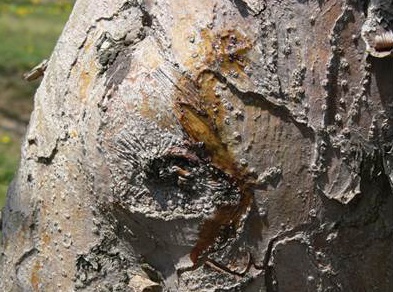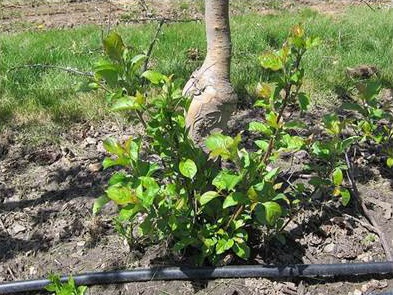Fire blight: consider an aggressive orchard management approach
Learn prevention techniques for fire blight in orchards.
The 2016 season has been a very difficult fire blight year in many apple orchards across the province, including in less susceptible varieties and orchards that have never had fire blight before. While the fire blight bacteria are always present in an orchard, the risk of infection varies year to year depending on environmental factors, management practices and overall tree health. Unfortunately, this year had ideal conditions at bloom for fire blight infection, including a long secondary bloom in many areas. Protection products such as Streptomycin degrade rapidly in UV and are only effective for about 2 days before reapplication is needed. Growers who did not spray a protectant product preventatively during bloom, spray frequently enough or at the proper timing, or did not remove secondary blossoms likely saw fire blight symptoms in their orchard.
The first line of defense for fire blight management in an orchard is prevention. There is no silver bullet to eradicate this disease once it becomes well established. Growers that dealt with fire blight this year should consider an aggressive orchard management approach, including the following:
Prune out infected tissue - Removing sources of inoculum as soon as possible will significantly reduce secondary infection. However, aggressive pruning early in the season on vigorous trees can worsen the situation by stimulating succulent shoots that will be susceptible to infection. Consider delaying pruning of older trees (>8-10 years) with many strikes until terminal bud set or when dormant. Keep in mind, however, that delayed removal of inoculum increases the risk of trauma blight in the event of severe wind, rain or hail later in the season.
Other key points to remember when pruning infected tissue:
- Cut at least 30 cm beyond the visible infected tissue (Figure 1), preferably into 2nd or 3rd year wood.
- Only prune out strikes when there are 2-3 consecutive days of low humidity and temperatures below 25°C.
- Regardless of when you prune, disinfect pruning tools between each cut by soaking them in a solution of 1 part bleach to 5 parts water or in a 65-70% alcohol solution.
- Prevent the spread of fire blight by not dragging infected material through the orchard. Cuts can be left in the row middles to dry up before removing or mulching them down.
- Scout the orchard for fire blight cankers (Figure 2) which can harbour active bacteria over the winter. Prune out limbs infected with cankers or, if necessary, remove the entire tree during the dormant season.
Figure 1. Visible margin of fire blight infection below which tissue appears healthy.
Figure 2. Fire blight canker becomes sunken with cracked margins. Bacteria ooze can be seen on the surface of canker in spring.
Remove root suckers - These adventitious shoots (Figure 3) are a fire blight management concern for several reasons:
- Provide an entry point for fire blight -Rootstocks that become infected from the scion often die a year later, whereas rootstock infection through a sucker die the same year. Susceptible rootstocks like M9 and M26 can die quickly after infection through root suckers.
- Provide an entry point for systemic herbicides (eg. glyphosate, amitrole) - These herbicides may weaken the tree and make them more susceptible to disease like fire blight.
- Attractive to late season sucking insects - Since root suckers continue to grow after terminal bud set, they can become an ideal site for insect pests later in the season. Sucking insects may transmit fire blight.
Figure 3. Root suckers of apple tree can provide entry point for fire blight bacteria. Photo: J. Clements, University of Massachusetts
Use registered control products - Consider applying a dormant copper next spring to kill bacteria that ooze out of overwintering fire blight cankers. Sprays can be applied from dormant through to green tip. However, green tip is the preferred timing of application as heavy rainfalls after application can partially wash off copper, reducing efficacy. Delaying copper after green tip can result in phytotoxicity and severe fruit russetting, depending on the copper product used.
Open blossoms tend to be the primary avenue for fire blight infection. Protecting these blossoms with timely applications of antibiotics (Streptomycin, Kasumin) and/or biologicals (Blossom Protect, Bloomtime, Serenade) is critical for management. Applications should be made when conditions are predicted to be conducive for bacteria build-up in the orchard using a forecasting model, such as CougarBlight or Maryblyt. Always rotate products to reduce the potential for resistance development.
Secondary blossoms (referred to as "rattail" or "tag" bloom) often open when environmental conditions for infection are high or extreme. Since they open much later than the majority of blossoms, they are often unprotected and therefore extremely vulnerable to fire blight infection. If possible, remove secondary blossoms immediately since they rarely produce marketable fruit and are more of a liability. Otherwise, continue with a bloom control program when a forecasting model predicts that there is a fire blight infection risk.


